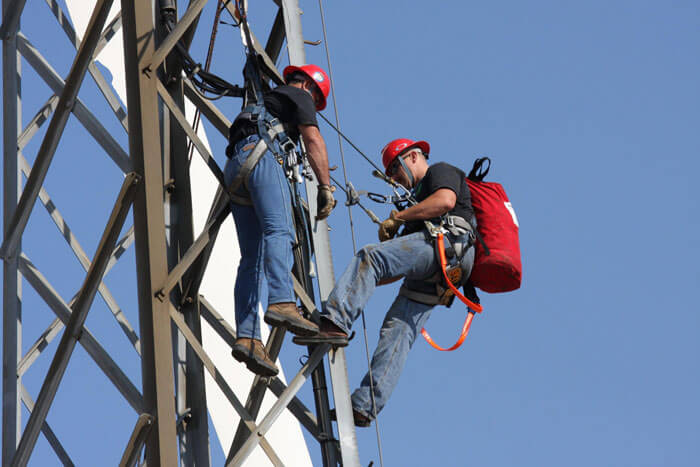

Tower climbing can be a thrilling and valuable occupation. Most the people who have this occupation love it and are intrigued by the danger. In the 80’s, it was a small and highly specialized industry, but with the growth of communication over the past 30 years, the demand has grown exponentially.
Some of the most common hazards in this field are falls from great heights, electrical hazards, bad weather, tower collapse, and equipment failure. Most of these are preventable by following not just the safety procedures of your company, but by using common sense.
The Biggest Tower Climbing Mistakes and recommended prevention methods are listed below. Most people who are in the field know that falls can happen but, the risk of RF radiation is often overlooked. When in doubt, follow common sense and avoid these mistakes:
1. Not having a proper climbing plan:
Scaling rung over hand, several hundred feet in the air while carrying an equipment bag, is not a process to be undertaken lightly. Before stepping on the the first rung, everyone in the group should be able to answer the following questions: Do the carriers know when the installers will be on the tower? Have all the appropriate permits been received? Have arrangements been made to reduce RF transmission levels? Have the LOTO procedures been implemented? Everyone on the team for each tower or set of towers should know that all of these guidelines have been followed.
2. Insufficient tower climbing certification:
Not just anyone can climb a tower and possess the skills needed to execute the maintenance successfully. Experienced climbers have the instincts needed to move up and down the tower but, like any technical job, the skills, changes, and safety updates made in the field must be periodically re-taught and certifications updated. A mistake made by experienced climbers is to get set in their ways and not implement new techniques.
3. Not maintaining climbing gear:
Climbing gear comes with an expiration date. After so many years, stress will be put on clips, harnesses, and straps making them no longer able to perform their proper safety function. Gear should be routinely checked for rips, tears, and chips, even if it is within its dates. It should also, be stored properly as sun exposure and other environmental factors can make it age prematurely. Once gear has reached its expiration date, even if it shows no signs of damage, it should be discarded.
4. Climbing without proper gear:
Weather changes up in the air can not always be detected from the ground. Every climber should have their glasses, gloves, jacket, helmet, boots, harness, lifeline, carabiners, rope grabs, lanyards, and tool belts on their person and in proper working order before the climb begins. It may be tempting to buy discounted or used gear but, when it comes to safety, paying the extra amount will be worth it.
5. Not keeping RF Personal alarm on:
RF signals can’t be seen. Even if towers have been reduced in their operations to reduce RF signals, there is no way to know for sure that they won’t be suddenly turned back on. Make sure it is charges and wear it outside of the suit. It could save your life.
6. Lack of proper signage:
Signs, especially those that warn of RF radiation, should be clearly visible. Weathering and vandalism may damage signs, they should be properly replaced and maintained so that all those involved can read them clearly. If communication towers are lacking these signs, they should not be climbed until the specific RF conditions can be verified.
Following these tips is the first step towards safety. In a dangerous field such as tower climbing, going the extra mile is worth the time.
